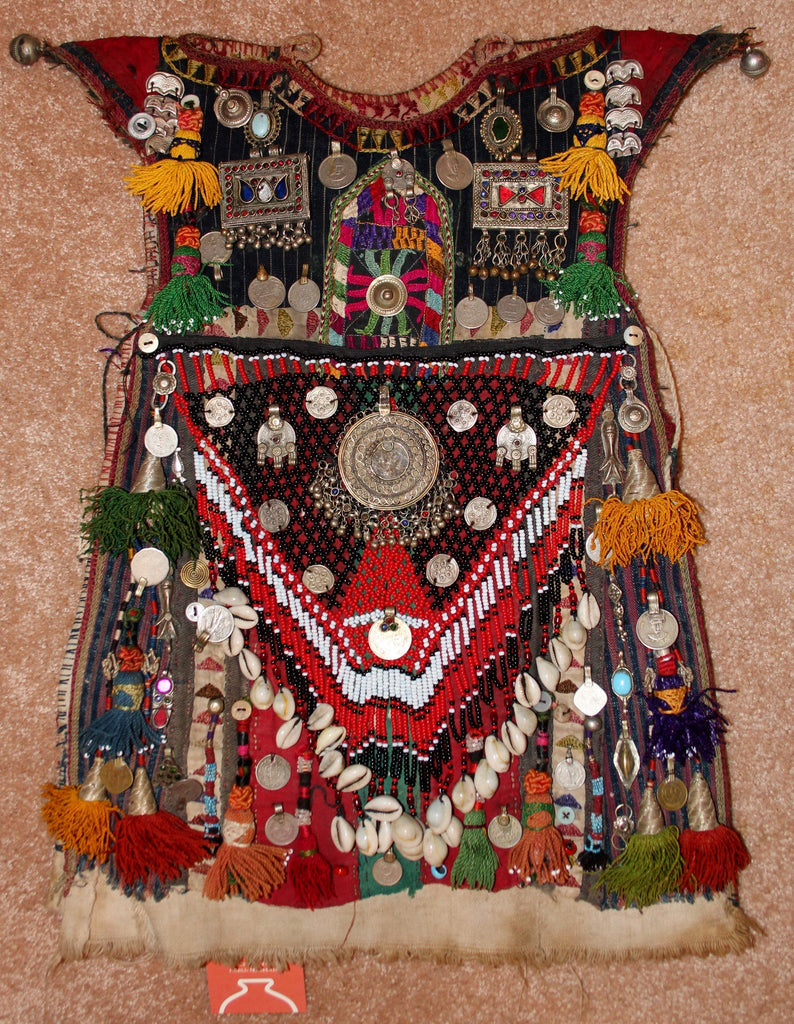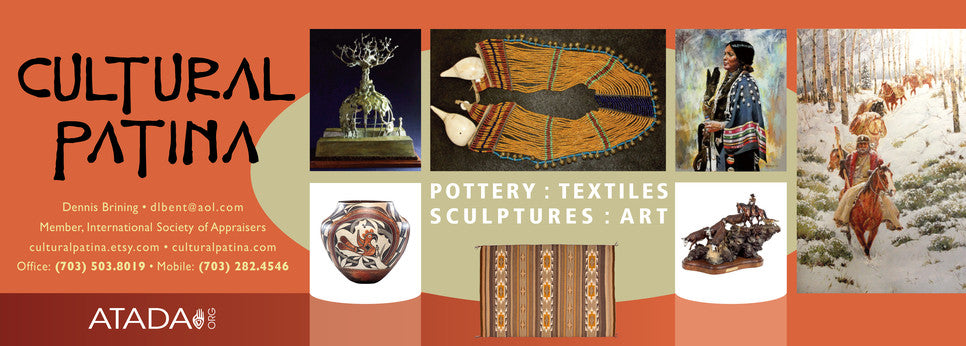
Nomadic Tekke-Turkmen Child's Ceremonial Garment, #909 Sold
$ 1,875.00
Nomadic Tekke-Turkmen
Child's Ceremonial Garment,
909. Description: Extraordinary Ethnic handmade Tekke-Turkman baby garment. Vintage Traditional Nomad child ceremonial garment. The garment is decorated by hand with handmade tassels, metals, coins, silver, shells, beads and other ornaments to protect against the evil eye. Front & Back are almost the same, heavily adorned with all these materials. It is a one of a kind piece of art for home decoration and/or wall hanging.
Dimensions: Length: 21” by 17” long
Condition: Very good condition for its age.
The proper name of the Tekke people is Teke. The misspelling Tekke is so common that I find it hard to go back and correct it. So I move forward using Teke in newer work.
The Teke were part of the Salyr (Salor) of the Oguz Turks. When the Oguz split over the issue of converting to Islam the Teke/Salyr coveted to Islam and became part of the Seljuk/Oguz. The Salyr split in the face of the Mongol onslaught. What we know today as Salor are those that stayed in Turkestan and came under the sway of the Mongols. The Teke emerged again in the 16th century as part of the Sayin Khan-Salor. At this point the Salor/Salar split occurred. The Teke with the Salor stayed in Turkestan under the domination of the Uzbek Mongols. A significant part of the Salyr moved east under the protection of the Mogholistan Khans. They are now in China as the Salar.
In the late seventeenth century the Salor confederation broke up which forced the three primary tribes of the confederation, the Salyr, the Saryk, and the Teke out of the Mangyshlak Peninsula and the Balkan Mountains. The tribes moved eastward and then south. this set off a series of incidents where the Saryk usurped the Salyr and then the Tekke/Teke usurped the Saryk. The Tekke/Teke were the dominant southern Turkmen tribe when the Russians came in. (Source: http://www.spongobongo.com/tekke.htm)
Some information on the Turkmen culture and people
The Turkmen people have traditionally been nomads and equestrians, and even today after the fall of the USSR attempts to urbanize the Turkmen have not been very successful. They never really formed a coherent nation or ethnic group until they were forged into one by Joseph Stalin in the 1930's. Rather they are divided into clans, and each clan has its own dialect and style of dress.
Turkmen are famous for making Turkmen rugs, often mistakenly called Bukhara rugs in the West. These are elaborate and colorful rugs, and these too help indicate the distinction between the various Turkmen clans.
The Turkmen are Sunni Muslims but they, like most of the region's nomads, adhere to Islam rather loosely and combine Islam with pre-Islamic animist spirituality. The Turkmen do indeed tend to be spiritual but are by no means militantly religious.
A Turkmen can be identified anywhere by the traditional "telpek" hats, which are large black sheepskin hats that resemble afros. The national dress: men wear high, shaggy sheepskin hats and red robes over white shirts. Women wear long sack-dresses over narrow trousers (the pants are trimmed with a band of embroidery at the ankle). Female headdresses usually consist of silver jewelry. Bracelets and brooches are set with semi-precious stones.
Language: Outside the capital, the national language of Turkmen is the most widely encountered. In Ashgabat, it would be hard to find a person who did not speak Russian, however with recent efforts to revive the ancient culture of Turkmenistan, Turkmen is quickly regaining its place as the chief language of the state.
Two significant figures in Turkmen literature are the poets Magtymguly Pyragy and Mämmetweli Kemine. Turkmen music is very similar to Khorasani music.( Source Wikipedia)
-----------
Some information on the Evil Eye Follows
-----------
The evil eye is a curse believed to be cast by a malevolent glare, usually given to a person when they are unaware. Many cultures believe that receiving the evil eye will cause misfortune or injury.Talismans created to protect against the evil eye are also frequently called "evil eyes".
The idea expressed by the term causes many different cultures to pursue protective measures against it. The concept and its significance vary widely among different cultures, primarily in West Asia. The idea appears several times in translations of the Old Testament. It was a widely extended belief among many Mediterranean and Asian tribes and cultures. Charms and decorations with eye-like symbols known as nazars, which are used to repel the evil eye are a common sight across Turkey, Greece, Albania, Egypt, Iran, Israel, Southern Italy (Naples), the Levant, and Afghanistan and have become a popular choice of souvenir with tourists. (Source: Wikipedia)
Child's Ceremonial Garment,
909. Description: Extraordinary Ethnic handmade Tekke-Turkman baby garment. Vintage Traditional Nomad child ceremonial garment. The garment is decorated by hand with handmade tassels, metals, coins, silver, shells, beads and other ornaments to protect against the evil eye. Front & Back are almost the same, heavily adorned with all these materials. It is a one of a kind piece of art for home decoration and/or wall hanging.
Dimensions: Length: 21” by 17” long
Condition: Very good condition for its age.
The proper name of the Tekke people is Teke. The misspelling Tekke is so common that I find it hard to go back and correct it. So I move forward using Teke in newer work.
The Teke were part of the Salyr (Salor) of the Oguz Turks. When the Oguz split over the issue of converting to Islam the Teke/Salyr coveted to Islam and became part of the Seljuk/Oguz. The Salyr split in the face of the Mongol onslaught. What we know today as Salor are those that stayed in Turkestan and came under the sway of the Mongols. The Teke emerged again in the 16th century as part of the Sayin Khan-Salor. At this point the Salor/Salar split occurred. The Teke with the Salor stayed in Turkestan under the domination of the Uzbek Mongols. A significant part of the Salyr moved east under the protection of the Mogholistan Khans. They are now in China as the Salar.
In the late seventeenth century the Salor confederation broke up which forced the three primary tribes of the confederation, the Salyr, the Saryk, and the Teke out of the Mangyshlak Peninsula and the Balkan Mountains. The tribes moved eastward and then south. this set off a series of incidents where the Saryk usurped the Salyr and then the Tekke/Teke usurped the Saryk. The Tekke/Teke were the dominant southern Turkmen tribe when the Russians came in. (Source: http://www.spongobongo.com/tekke.htm)
Some information on the Turkmen culture and people
The Turkmen people have traditionally been nomads and equestrians, and even today after the fall of the USSR attempts to urbanize the Turkmen have not been very successful. They never really formed a coherent nation or ethnic group until they were forged into one by Joseph Stalin in the 1930's. Rather they are divided into clans, and each clan has its own dialect and style of dress.
Turkmen are famous for making Turkmen rugs, often mistakenly called Bukhara rugs in the West. These are elaborate and colorful rugs, and these too help indicate the distinction between the various Turkmen clans.
The Turkmen are Sunni Muslims but they, like most of the region's nomads, adhere to Islam rather loosely and combine Islam with pre-Islamic animist spirituality. The Turkmen do indeed tend to be spiritual but are by no means militantly religious.
A Turkmen can be identified anywhere by the traditional "telpek" hats, which are large black sheepskin hats that resemble afros. The national dress: men wear high, shaggy sheepskin hats and red robes over white shirts. Women wear long sack-dresses over narrow trousers (the pants are trimmed with a band of embroidery at the ankle). Female headdresses usually consist of silver jewelry. Bracelets and brooches are set with semi-precious stones.
Language: Outside the capital, the national language of Turkmen is the most widely encountered. In Ashgabat, it would be hard to find a person who did not speak Russian, however with recent efforts to revive the ancient culture of Turkmenistan, Turkmen is quickly regaining its place as the chief language of the state.
Two significant figures in Turkmen literature are the poets Magtymguly Pyragy and Mämmetweli Kemine. Turkmen music is very similar to Khorasani music.( Source Wikipedia)
-----------
Some information on the Evil Eye Follows
-----------
The evil eye is a curse believed to be cast by a malevolent glare, usually given to a person when they are unaware. Many cultures believe that receiving the evil eye will cause misfortune or injury.Talismans created to protect against the evil eye are also frequently called "evil eyes".
The idea expressed by the term causes many different cultures to pursue protective measures against it. The concept and its significance vary widely among different cultures, primarily in West Asia. The idea appears several times in translations of the Old Testament. It was a widely extended belief among many Mediterranean and Asian tribes and cultures. Charms and decorations with eye-like symbols known as nazars, which are used to repel the evil eye are a common sight across Turkey, Greece, Albania, Egypt, Iran, Israel, Southern Italy (Naples), the Levant, and Afghanistan and have become a popular choice of souvenir with tourists. (Source: Wikipedia)
Related Products
Sold out






